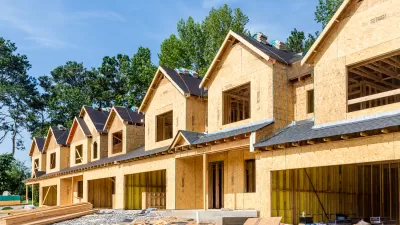Many families cannot afford to live in San Francisco, where housing prices are high and houses fit for families raising children are hard to come by.

One side effect of the high cost of housing in San Francisco is that it’s pushing families out of the city. "San Francisco notoriously has the smallest percentage of kids — 13.4 percent — of any city in the nation. But while San Francisco officials sweat and bicker over affordable housing, they rarely talk about family housing," reports Heather Knight for the San Francisco Chronicle.
Supervisor Norman Yee commissioned the city's planning department to come up with a report on the issue, and the results paint a grim picture for families. "Of all the homes across San Francisco with three or more bedrooms, just 30 percent of them are occupied by families with children. Many of them are inhabited by unrelated roommates, couples whose kids are grown or single people," writes Knight. The kind of demand that has families competing with singles that would break them up points to an extraordinary demand for housing of many kinds, Yee feels the problem is caused, in part, by what developers wish to build. "Yee said he’s tired of seeing plans for high-rises filled with studios and one-bedroom apartments and open spaces that are clearly designed for adults," Knight writes. It's also the case that there's simply a great deal of demand, some of which may be due to Yee and others opposing dense low-income developments.
FULL STORY: SF housing shortage leaves little room for families

Pennsylvania Mall Conversion Bill Passes House
If passed, the bill would promote the adaptive reuse of defunct commercial buildings.

Planning for Accessibility: Proximity is More Important than Mobility
Accessibility-based planning minimizes the distance that people must travel to reach desired services and activities. Measured this way, increased density can provide more total benefits than increased speeds.

Fair Housing Cannot Take a Back Seat to ‘Build, Baby, Build’
If we overlook fair housing principles in the plan to build US housing back better, we risk ending up right back where we started.

LA Metro Board Approves New 710 Freeway Plan
The newest plan for the 710 corridor claims it will not displace any residents.

Austin’s Proposed EV Charging Rules Regulate Station Locations, Size
City planners say the new rules would ensure an efficient distribution of charging infrastructure across the city and prevent an overconcentration in residential areas.

Making California State Parks More Climate-Resilient
A recently released report offers recommendations for keeping state parks healthy and robust, including acquiring additional land for conservation and recreation.
City of Costa Mesa
Licking County
Barrett Planning Group LLC
HUD's Office of Policy Development and Research
Mpact Transit + Community
HUD's Office of Policy Development and Research
Tufts University, Department of Urban and Environmental Policy & Planning
City of Universal City TX
ULI Northwest Arkansas
Urban Design for Planners 1: Software Tools
This six-course series explores essential urban design concepts using open source software and equips planners with the tools they need to participate fully in the urban design process.
Planning for Universal Design
Learn the tools for implementing Universal Design in planning regulations.


























